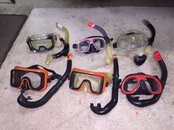The TUSA HyperDry snorkel is one of the better snorkels, but it does have resistance built into it. The end piece, along with the curve of the ent of the tube, are designed to keep water from waves out, but also provide just enough resistance that with a sharp exhalation water can be cleared out of the bottom of the snorkel. I used mine in the pool today, and Imdo enjoy it.Tusa Hyperdry doesn't seem to restrict my breathing any more than a J-snorkel. Really dry. I've ended up with a bunch of them because they come with the mask, which is my favorite.
I also have the TUSA (for Tabata USA) HyperDry Imprex mask, which I like a lot. I bought it for my wife in the late 1990s, but now that she has a new mask, I inherited it from her. The only down-side to this mask is that the mask is clear silicone, and I see the strap knuckle system as a black dot to the side of my vision on each side. I really like the purge valve on the front of the mask, and the fact that it can be removed for cleaning. It is number 3 in the photo. Below.
SeaRat




